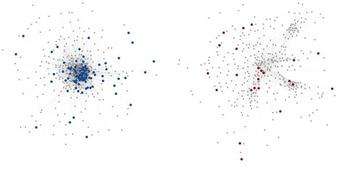In gene networks, it's location, location, location

From appearance to endurance, nature's adaptations all trace back to complex molecular networks of living things. Improving our understanding of how genes give rise to outward adaptations may hinge on three concepts from network science – location, location, location.
Take the example of the humble winter weed Arabidopsis thaliana, the first plant species to be genetically sequenced. Past experimental attempts to find the genetic origins of the plant's cold and draught tolerance turned up idiosyncratic results.
In 2014, an SFI working group co-organized by Sam Scarpino, Jesse Lasky, David Des Marais, and Rafael Guerrero helped make sense of the data using network algorithms to analyze Arabidopsis's genetic activation network – the labyrinthine chemical pathways of gene expression.
It turns out that the genes involved in the weed's extreme-weather adaptations occupy vastly different spots in the network: cold genes are densely clustered and highly connected in the center, and thus greatly influence genes farther along the expression pathways. Drought genes, in contrast, lie near the endpoints.
Simply put, "it's biology that matters most," says Scarpino, explaining that knowing gene distribution in a molecular network, rather than just the statistics of gene expression, is crucial in understanding adaptations.
With that established, the groundwork is laid for explaining the role of molecular networks in adaptation. The Molecular Networks and Evolution Across Biological Scales Evolution working group met again last month to develop a general theoretical framework, then test it using reciprocal transplant experiments of Arabidopsis and the wild grass Brachypodium.
Joining the group were SFI Omidyar Fellows Josh Grochow and Chris Kempes and SFI Postdoctoral Fellow Laurent Hébert-Dufresne.
Scarpino reckons that if their experiments hold up, they'll be midway to constructing a workable theory of molecular networks in evolution. Even if the experiments fall through, though, "we've had a breakthrough in the conceptual understanding of this question," he says. "If we're wrong, we're wrong for the right reasons."
Provided by Santa Fe Institute





















